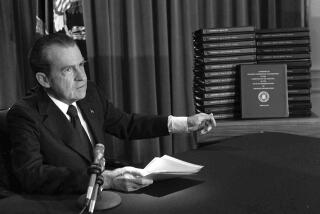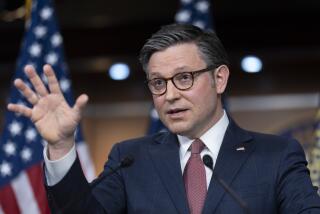Cutting Deficit Requires Tax Hike
So the fiscal 1986 budget is to be cut by $50 billion. No one is quite sure where the $50-billion figure originally came from, but it has somehow become the standard currency to describe what the Reagan Administration and Congress both plan to accomplish.
Maybe the figure came from the fact that the deficit is currently about $200 billion in round numbers and, since Reagan has four more years to go, $200 billion divided by four is $50 billion.
In any case, Federal Reserve Board Chairman Paul A. Volcker picked up on the number as well, and he said that $50 billion in spending cuts was the minimum requirement for the Fed to be accommodative; he repeated these comments in testimony before the Joint Economic Committee. So it cannot possibly have come as any surprise when the budget document included precisely $50.8 billion in cuts relative to the so-called current services budget. But the important information is not what the President submitted in his budget message but what Congress will finally end up doing. Hereâs a brief synopsis:
Defense spending: The Administration has asked for a $32-billion increase, or 12.6%. They will be lucky to get $20 billion of that. Defense Secretary Caspar W. Weinberger has weakened his case by attempting to stonewall Congress. It didnât work for President Johnson, and it didnât work for President Nixon; itâs a mystery why Weinberger thinks he can succeed where so many others have failed. The first major order of business for Congress will be to knock the Weinberger defense budget into a cocked hat. Then the legislators can proceed to other business.
Freeze on Medicare, Medicaid
Health care: The Administration has requested a freeze on the payment schedules for Medicare and Medicaid, meaning no increase in doctor or hospital fees. This one is likely to go through; once the defense budget has been hacked apart, legislators will feel some obligation to turn the other blade on social welfare services. Since most economists, let alone politicians, are at a loss to explain why health-care costs rose about 6% more than inflation in 1982 and 1983, this seems like an eminently reasonable--and fair--place to make substantial budget cuts.
Aid to farmers: The Administration has asked for a 37% cut in these programs. The response from Congress will be that it is a good, sound ideal but not âthisâ year, when the farmers are down and out on their luck. Which means, of course, not any year. As a matter of fact, the Administrationâs farm policy, like its immediate predecessorsâ, is a mess.
The right idea would be to let the farmers grow surplus grains and then sell on world markets at whatever the going price happens to be, instead of pricing farmers out of the market because of the overvalued dollar. Of course, that would cost some money, but it would be a lot cheaper than the present schemes and would ensure the long-term viability of our agricultural sector. This is the doctrine that has been preached by former Agriculture Secretary Earl Butz for years. Donât look for Congress to go that route.
Eliminate revenue sharing: While cloaked in righteous pieties, the main reason for this punitive move is to show the state legislatures whoâs really the boss. Since many states have a habit of telling Washington to balance its budget, what better way than by cutting off aid to the very states that are complaining the loudest. But the whole approach is mean-spirited and will not get a decent hearing in Congress.
Cut government pay by 5% and freeze retirement benefits for a year: The freeze on retirement benefits probably will go through and may even be accompanied by a one-year freeze on Social Security benefits as well. If both of these pass, government employees will forgo their raises next year as well. But an actual 5% pay cut is out of the question.
User Fees
Implement user fees: Here is a sensible idea that has been proposed by leaders of both parties for years but never gets anywhere. The idea of individuals paying for the specific federal resources they use would seems to be an unobjectionable suggestion that both Democrats and Republicans could handle. But it always gets bogged down in the hokum about making available âour priceless national heritageâ to all Americans regardless of race, creed, color or pocketbook. This legislation wonât get any further this year than it has in the past.
Tax reform: The glaring omission in the budget message was that tax reform increases were not mentioned at all. Not even a token reference. That grandiose Treasury plan didnât even rate a single line in the 1986 budget. We are promised a draft version from the President âlater.â What really happened is quite obvious: The big-business lobbyists made it quite clear to the White House that, if the Administration was going to try and take away all their tax breaks, they would be so busy defending the status quo that they wouldnât have any time left whatsoever to support the spending cuts. The Administration got the message, and it promised to propose tax legislation some other time. Maybe some other year. Even better, maybe some other Administration.
And now for the bad news. Suppose we really do get the modified freeze--Social Security, Medicare, government employee raises and retirement benefits--and Congress does shake $12 billion off the defense budget. Total non-defense outlays for this year have crept up so much when no one was looking--$43 billion, to be exact--that the deficit for 1986 will still be more than $200 billion. In fact, even with all the cuts proposed in the recent budget, the non-defense spending totals for next year are still $7 billion higher than the original 1986 estimates issued last year, which didnât even have a freeze built into the figures.
That means tax increases--not revenue neutrality, but revenue increases. We expect a $25-billion tax increase, mostly on the corporate side. This will take the form of some rollback in the investment tax credit and closing loopholes for financial institutions. However, even that wonât be sufficient to make a dent in the deficit--nor will it affect interest rates.
For even under our most optimistic assumptions about reducing deficits, the fiscal 1986 deficit is still $7 billion higher than the 1984 figure. This includes a $12-billion slash in the defense budget; a one-year freeze for Social Security, Medicare, government pay and retirement benefit, and a $25-billion increase in personal and corporate income taxes. Yet, these major changes still leave a deficit $12 billion above announced Administration goals. Furthermore, under a realistic economic scenario, the deficit figures worsen again after 1986.
It is not reasonable to assume that the freeze on pay and retirement benefits will be continued for more than one year, and even if defense spending only grows 5% per year in real terms, the deficit continues to balloon because the steady increase of almost $25 billion per year in net interest paid. The deficit hardly shrinks at all even under the Administration estimate of 4% real growth, whereas if a recession were to occur anytime in the next four years, the figures become even more dismal.
Finally, the coup de grace is that all this huffing and puffing over deficit reduction will not have a noticeable effect on interest rates. Last year, the deficit was $185 billion, or 5.1% of the gross national product. This year, according to Administration figures, it will be 5.8% of GNP. Next year, according to our optimistic estimates, it might decline as far as 4.5% of GNP. This is progress only in the most halting fashion and would reduce interest rates only about one-half percentage point relative to the 1984 levels--assuming no other changes in the economy.
However, the behavior of the overall economy obviously must also be considered in determining where interest rates will head. Given that real growth will average almost 5% in 1985, interest rates are almost sure to rise in the latter half of this year and continue increasing during at least the first half of 1986. As a result, the decline in rates that might have occurred due to the smaller deficit will be overwhelmed by the increase due to the strong economy, excessive growth in money and credit aggregates and the increase in inflation later this year.
Thus, even if the deficit were to be reduced by as much as $30 billion next year, we would still predict an increase in interest rates during 1985 and 1986. Just as the increase in the deficit surprised everyone by not raising inflation, the decline in the deficit will surprise âeveryoneâ by neither improving the growth rate nor lowering interest rates.
More to Read
Get the L.A. Times Politics newsletter
Deeply reported insights into legislation, politics and policy from Sacramento, Washington and beyond. In your inbox three times per week.
You may occasionally receive promotional content from the Los Angeles Times.










